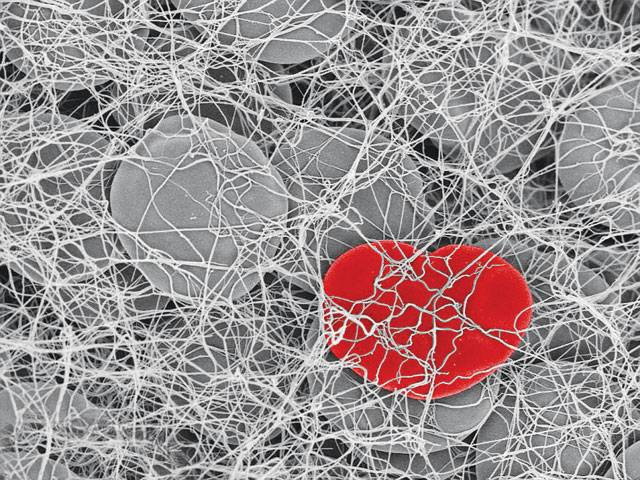LONDON-This astounding photo of a heart-shaped cell entangled in a blood clot has won the British Hearth Foundation's 2017 photo contest.
In the image, which was captured through an electron microscope, red blood cells are trapped in the 3D mesh of fibrin fibres, which hold the clot together. The cell had remarkably been compressed into a heart shape by the contracting fibres surrounding it.
These fibrin fibres have the ability to stretch without breaking to more than five times their original size.
The image was snapped by a University of Leeds researcher who is studying how clots form.
'I was amazed when I saw the blood cell which by chance had been squeezed into a heart shape', said the overall winner, Fraser Macrae.
'As someone who is investigating aspects of heart disease, it seemed to be very symbolic.
'By understanding the difference between deadly clots in patients with cardiovascular disease and clots which help us when we've been injured, we hope to design new drugs that remove damaging clots or prevent their formation, ultimately saving lives.'
It is the second time the researcher has won the competition, after an image he took in 2015 of the clotting process impressed the judges.
Other shortlisted entries included an image of the blood vessel network inside a zebrafish heart and the immune system at work inside a muscle.
'This image tells a story of how science and art can come together to help advance our knowledge of modern medicine', said competition judge Christopher Jackson.
'At the same time, images like this give us the opportunity to appreciate the incredible beauty in something that is invisible to the human eye.'
A photo taken by Dr Sean Davidson shows a thin section of a mouse heart with a cross-section of blood vessels that look rather like a heart itself.
The heart muscle and vessel walls appear red, while the nucleus - the control centre of the cell - appears blue.
Another image taken by Dr Simon Wilson from the University of Edinburgh shows a blood clot forming in a healthy human blood vessel.
Each year in the UK about 100,000 people die from a heart attack or stroke caused by unwanted blood clots, according to the British Heart Foundation.






